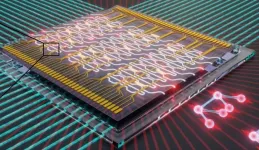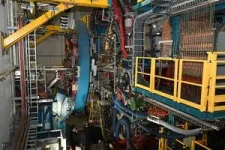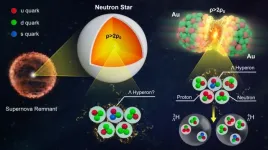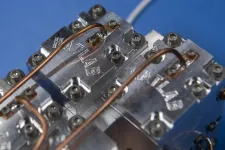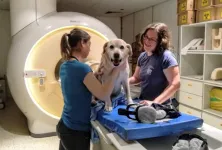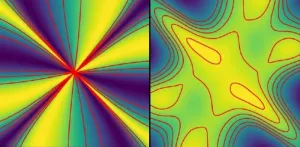(Press-News.org) Researchers at the Niels Bohr Institute have, collaborating with the University of Münster and Ruhr-Universität Bochum, developed new technology capable of processing the enormous amounts of information quantum systems generate. Deterministic single photon light sources, creating quantum bits at extreme rates and speed are now coupled to specially designed, integrated photonic circuits, capable of processing quantum information with adequate speed and quality without degrading the susceptible quantum states. This means that the first steps have been taken towards the development of photonic quantum devices that can, for example, describe and simulate other complex quantum systems - like the vibrational dynamics of biological molecules. The result is published in Science Advances.
The long haul now shows its value
Professor Peter Lodahl and the research group Quantum Photonics at the Niels Bohr Institute, University of Copenhagen have worked in this field for nearly twenty years. In short, it is all about the use of single photons, the smallest parts of light, used to code quantum information.
This is a rapidly developing field, demonstrating a single-photon encrypted communication link in the autumn of 2022 and a recent record investment in the spin-out business Sparrow Quantum.
At the core of it all are the photon sources developed and refined by the group over many years. Presently with unparalleled control, precision and quality, opening the doors to new research and development in quantum technology.
Quantum simulator – what’s all that about?
As soon as the word “quantum” is on the table it is often followed by the word “computer” – the idea of an extremely strong platform for calculations, with the capacity of dealing with complex problems.
Peter Lodahl says that the work done in connection with this result points in the direction of what they call a “quantum simulator”.
A quantum simulator is a special-purpose computer that simulates quantum systems by processing quantum information (quantum bits) that classical computers have a hard time dealing with.
“The processing of quantum information demands an exponentially increasing capacity on a classical computer when increasing the number of quantum bits. This means that even rather simple quantum mechanical problems cannot be solved on classical computers”, says Stefano Paesani, one of the leading researchers behind the result.
What is the purpose of a quantum simulator?
What does “processing” quantum information mean? This is where a crucial interdisciplinary element comes in.
Within the framework of the Novo Nordisk Foundation Project, “Solid-State Quantum Simulators for Biochemistry (SolidQ)”, photons, interacting in a photonic circuit, can be used to describe the characteristics of biochemical processes.
You can use one system (photons) to learn about the other system (the biomolecule) because the photonic quantum simulator can process the complex quantum information that describes it. One of the challenges consists in understanding the connection between the two complex quantum systems.
A quantum simulator relies on the congruence between different quantum systems
“We can learn about one system by studying the other – i.e. you can “map” one system to another. The initial insight into a complex system is crucial, however.
For example, there is a natural mapping occurring between photons and the vibration dynamics of molecules: When a molecule vibrates its evolution is described by the same quantum mechanical operation that describes photons sent through a circuit.”, says Peter Lodahl.
Technologies must “shake hands”
The challenge is to process the photons blasting away at the speed of light and in high numbers. It must happen extremely quickly and without loss. Not too many errors are allowed to happen.
Collaborating with the University of Münster the groups have, over the last two years, developed photonic circuits capable of processing quantum bits from the photonic source – and have made the two systems fit together. The Novo Nordisk Foundation project SolidQ has been all about optimizing the processing of photons.
“The collaboration with Münster is a great example of the fact that the research community takes the first steps. Subsequently, we make a “road map” for up-scaling the technology.
This platform looks very promising indeed and in working with Münster we succeeded in realizing photonic circuits adequately efficient and fast to keep up with our photon sources. We’re opening the door to applications now”, says Stefano Paesani.
END
Promising building blocks for photonic quantum simulators
2023-05-26
ELSE PRESS RELEASES FROM THIS DATE:
First measurements of hypernuclei flow at RHIC
2023-05-26
UPTON, NY—Physicists studying particle collisions at the Relativistic Heavy Ion Collider (RHIC) have published the first observation of directed flow of hypernuclei. These short-lived, rare nuclei contain at least one “hyperon” in addition to ordinary protons and neutrons. Hyperons contain at least one “strange” quark in place of one of the up or down quarks that make up ordinary nucleons (the collective name for protons and neutrons). Such strange matter is thought to be abundant in the hearts of neutron stars, which are among the densest, most exotic objects in the universe. While blasting off to neutron stars to study ...
When the cell digests itself: How inherited neurodegenerative diseases develop
2023-05-26
FRANKFURT. A tangle of pockets, tubes and sac-like membrane structures runs through the cells of humans, animals, plants and fungi: the endoplasmic reticulum, or ER for short. In the ER, proteins are manufactured, folded into their three-dimensional structure and modified, lipids and hormones are produced and calcium concentrations in the cell are controlled. In addition, the ER forms the basis for the cellular transport system, feeds misfolded proteins to intracellular disposal and renders toxins that have entered the cell harmless.
In ...
Army funds two quantum-related projects at Pitt
2023-05-26
The U.S. Army has awarded more than $5.7 million for two projects led by Michael Hatridge, associate professor of physics and astronomy in the Kenneth P. Dietrich School of Arts and Sciences. Both projects bring together a diverse group of researchers to overcome roadblocks in the field of quantum computing.
A four-year, $2.67 million grant is aimed at the next generation of modular quantum computing systems. Hatridge and co-principal investigators Robert Schoelkopf of Yale University have each developed unique ...
Emergence of solvated dielectrons observed for the first time
2023-05-26
Solvated dielectrons are the subject of many hypotheses among scientists, but have never been directly observed. They are described as a pair of electrons that is dissolved in liquids such as water or liquid ammonia. To make space for the electrons a cavity forms in the liquid, which the two electrons occupy. An international research team around Dr. Sebastian Hartweg, initially at Synchrotron SOLEIL (France), now at the Institute of Physics at the University of Freiburg and Prof. Dr. Ruth Signorell from ETH Zurich, including scientists ...
Networks in the dog brain
2023-05-26
A study on canine brain networks reveals that during mammalian brain evolution, the role of the cingulate cortex, a bilateral structure located deep in the cerebral cortex, was partly taken over by the lateral frontal lobes, which control problem-solving, task-switching, and goal-directed behavior. The study relies on a new canine resting state fMRI brain atlas, which can aid in the analysis of diseases characterized by dysfunctional integration and communication among brain areas.
Researchers interested in how dogs think can not only deduce it from their behavior, but they can also investigate their brain activity using fMRI (functional ...
Fractons as information storage: Not yet quite tangible, but close
2023-05-26
Excitations in solids can also be represented mathematically as quasiparticles; for example, lattice vibrations that increase with temperature can be well described as phonons. Mathematically, also quasiparticles can be described that have never been observed in a material before. If such "theoretical" quasiparticles have interesting talents, then it is worth taking a closer look. Take fractons, for example.
Perfect storage of information
Fractons are fractions of spin excitations and are not allowed to possess kinetic energy. As a consequence, they are completely stationary and immobile. This makes fractons new candidates for perfectly secure information storage. Especially since ...
Defence lawyers face challenges accessing and reviewing digital evidence, study shows
2023-05-26
Defence lawyers face numerous challenges accessing and reviewing evidence from phones and computers, a new study shows.
Solicitors and barristers have reported their use of digital evidence can be restricted by limited or late access, large volumes of material, and tight turnaround times to secure legal aid funding and choose and instruct independent experts.
The research calls for more clarity and transparency around the collection and analysis of digital evidence and the streamlining of the format and presentation of information.
The current volume and diversity of digital evidence available escalates tensions, delays access to digital ...
Barren habitat for sows leaves imprint on piglets’ brains
2023-05-26
In a new study, researchers from Uppsala University in Sweden, together with colleagues from the University of São Paulo, Brazil, have investigated the impact that a barren living environment for sows leaves on the next generation. The pigs in the study were bred in Brazil and kept according to breeding standards in that country. The sows’ uncomfortable and unstimulating environment brought with it several different types of changes in the epigenome of their offspring.
In many parts of the world, sows are kept confined in concrete stalls while they are pregnant. This is a bad environment for the pigs, both in terms ...
Quantum sensor for a future navigation system tested aboard Royal Navy ship
2023-05-26
A prototype quantum sensor with potential applications in GPS-free navigation, developed at Imperial College London, has been tested in collaboration with the Royal Navy.
The test marks an important step in bringing new quantum technologies out of the lab and into real-world settings.
Many navigation systems today rely on global navigation satellite systems (GNSS), such as GPS, which uses signals from satellites orbiting the Earth. However, GPS navigation is not always accessible, obstacles like tall buildings can easily block the satellite signals, and they are also susceptible ...
Hydrogen sulfide in cancer treatment
2023-05-26
Hydrogen sulfide is usually a highly toxic gas. However, with careful preparation, it can be used to support photothermal therapy (PTT) in treating cancer, as a team of researchers reporting in the journal Angewandte Chemie has recently discovered. As the team reports, an adjuvant releasing hydrogen sulfide causes tumor cells to lose their natural heat protection and thus to become significantly more sensitive to PTT.
Breathing in gaseous hydrogen sulfide usually causes us to suffocate, because the gas suppresses the respiratory chain in the mitochondria, ...
